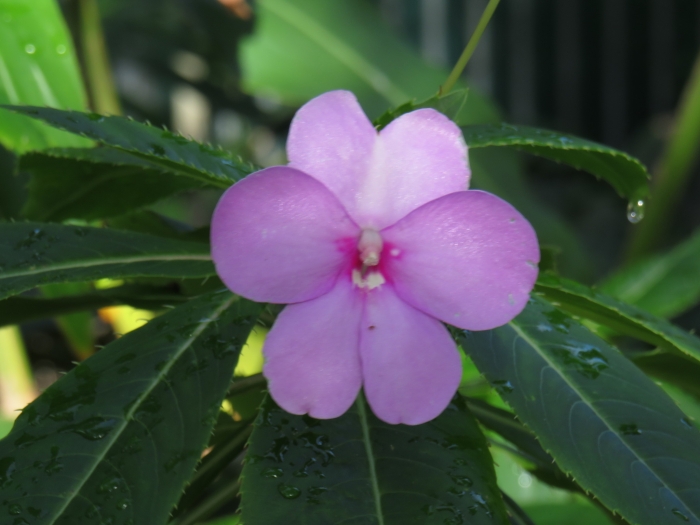Oliver’s Touch-Me-Not
(Impatiens sodenii)
Oliver’s Touch-Me-Not (Impatiens sodenii)
/
/

Jeremy Gilmore
CC BY 4.0
Image By:
Jeremy Gilmore
Recorded By:
Copyright:
CC BY 4.0
Copyright Notice:
Photo by: Jeremy Gilmore | License Type: CC BY 4.0 | License URL: http://creativecommons.org/licenses/by/4.0/ | Rights Holder: Jeremy Gilmore | Publisher: iNaturalist | Date Created: 2020-06-20T12:27:23-07:00 |



















































Estimated Native Range
Summary
Impatiens sodenii, commonly known as Oliver’s Touch-Me-Not, is an evergreen shrub or subshrub native to the highland forests and occasionally found in riparian zones and scrublands of Eastern Africa. It typically grows up to 1.5 meters tall and is characterized by its succulent stems that become woody at the base. The plant is glabrous, with leaves often arranged in whorls of up to 12 at the branch tips. Its flowers, which can bloom throughout the year, are usually white or pink with potential darker markings and reach up to 5 centimeters across. The flowers are quite showy and can add a splash of color to any garden setting.
Oliver’s Touch-Me-Not is valued for its continuous flowering habit and has earned the Royal Horticultural Society’s Award of Garden Merit. It is commonly used as an ornamental garden shrub, appreciated for its ease of maintenance and adaptability to a range of garden conditions. It thrives in moist, well-drained soil and prefers partial shade, though it can tolerate full sun in cooler climates. While it is generally easy to care for, it can be susceptible to fungal diseases in humid conditions. Gardeners should be aware of its potential invasiveness when grown outside its native range; it can spread rapidly in suitable climates, so it is essential to check local regulations before planting. Popular cultivars include the white-flowered ’Madonna’, which is particularly noted for its striking blooms.CC BY-SA 4.0
Oliver’s Touch-Me-Not is valued for its continuous flowering habit and has earned the Royal Horticultural Society’s Award of Garden Merit. It is commonly used as an ornamental garden shrub, appreciated for its ease of maintenance and adaptability to a range of garden conditions. It thrives in moist, well-drained soil and prefers partial shade, though it can tolerate full sun in cooler climates. While it is generally easy to care for, it can be susceptible to fungal diseases in humid conditions. Gardeners should be aware of its potential invasiveness when grown outside its native range; it can spread rapidly in suitable climates, so it is essential to check local regulations before planting. Popular cultivars include the white-flowered ’Madonna’, which is particularly noted for its striking blooms.CC BY-SA 4.0
Plant Description
- Plant Type: Shrub, Subshrub
- Height: 3-5 feet
- Width: 1.5-3 feet
- Growth Rate: Moderate
- Flower Color: Pink, White
- Flowering Season: Spring, Summer, Fall
- Leaf Retention: Evergreen
Growth Requirements
- Sun: Part Shade
- Water: Medium
- Drainage: Medium
Common Uses
Bird Garden, Butterfly Garden, Drought Tolerant, Groundcover, Hummingbird Garden, Low Maintenance, Showy Flowers
Natural Habitat
Highland forests, riparian zones, and scrublands of Eastern Africa
Other Names
Common Names: Shrub Balsam, Poor Man’s Rhododendron, Olivers Springkraut
Scientific Names: , Impatiens sodenii, Impatiens oliveri, Impatiens magnifica, Impatiens thomsonii, Impatiens uguenensis, Impatiens elgonensis,
GBIF Accepted Name: Impatiens sodenii Engl. & Warb. ex Engl.